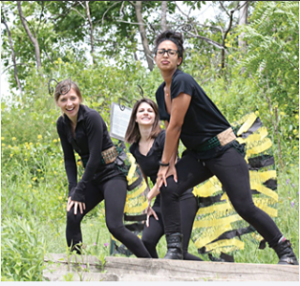City Love and the Arts – Creating Stronger Community Connections
 By Deborah Lynn Blumberg
By Deborah Lynn Blumberg
When you think of civic engagement, what comes to mind?
Is it a city council meeting or public hearing taking place in a government building, or an alert going to residents through the city website?
Often the interactions between city officials and residents are formal, structured, and impersonal. And, while they can be productive and informative, they can also be limiting.
Instead, imagine — what if city council meetings took place in a local park where residents and officials mingled outdoors rather than in a council chamber where leaders are positioned behind large podiums? Or, perhaps, public engagement around city planning initiatives could happen at an art gallery, watering hole, or special community landmark like a natural amphitheater.
Reimaging civic engagement is a cornerstone of Ash Hanson’s work. She is a place-based theater artist and creative executive officer (CEO) of the artist-led nonprofit, Department of Public Transformation (DoPT), who will be presenting at the League of Minnesota Cities 2023 Annual Conference.
Through art, creative engagements, and theater, Hanson helps communities invigorate places and spaces that forge deeper connections between the people who live there with the goal of strengthening cities.
The ripple effect of reciprocity
More connected, resilient communities have become increasingly crucial today as leaders work to foster economic growth amid stubbornly high inflation, climate change, and ongoing public health hurdles. Residents who’ve felt socially isolated over the last several years need new ways to reconnect, too. Play is critical to forging these key connections, says Hanson.
“Don’t underestimate the power of play,” she says. “When you address serious matters in a playful way, it has the potential to get more people involved.”
However, to truly strengthen communities and prepare them well for the future, leaders and residents alike also need to love their city, celebrate their community’s uniqueness, and become more deeply and authentically connected to their place and to the people who live and work there, Hanson says.
“If we love our places, and we feel like our places love us back — and that part is very important — then we have a desire to be caregivers and stewards of those places that we love,” she says. “It’s a ripple effect of reciprocity.”
Artists have an important part to play in fostering these connections, she says, working hand-in-hand with city leaders and residents.
The power of stories
Hanson, whose family hails from Aitkin County, became interested in theater at an early age. She went on to earn a master of arts degree in applied theater from the University of Manchester in the U.K.

At the same time, she wanted to stay connected with rural communities and help change stereotypes associated with them, including a “doom and gloom” view of their disrepair and demise. She saw storytelling as a way to elevate and connect rural communities. As a result, Hanson founded Place- Base Productions, a theater company that works in partnership with small cities and rural communities to create original, site-specific musicals celebrating small-town life. She and her team have partnered with Minnesota leaders and residents to put on dozens of plays that create deep community connections. To do this, PlaceBase builds on the work of local artists already working in communities.
“There are so many people doing impactful work,” Hanson says. “We’re part of a stream, and we can see these ripples of impact.”
Everyone has a part to play in Appleton
Appleton, a city of about 1,400, invited Hanson to produce a show. The city had recently shut down a prison, which was one of its main sources of economic viability, and jobs were lost.
“It felt like Appleton needed a little boost of joy and hope,” she says, and to reimagine itself — what it could be and what it wanted to be.
She and her playwright collaborator spent a year in the city, first interviewing residents and leading story circles to understand the heart and the soul of the community, then writing the script.
Community members became characters in the play and scene locations were ones meaningful for community members — the banks of the local river, the high school gym. Residents and local leaders, including mayors, act in these outdoor, site-specific productions and perform other roles, too.
For example, a resident who likes to sew might make costumes, construction workers do set design, and the karaoke host at the town bar runs the sound.
“Playing silly theater games with your neighbors is such a fun way to break down barriers,” Hanson says. One day residents in the Appleton play brainstormed what the Main Street of their dreams would look like. The possibilities are limitless, Hanson told them — a rollercoaster winding down the street or an endless supply of fudge on hand.
“Getting involved in a production like this, people see that change is possible, that the Main Street of their dreams could be possible,” she says. “People meet each other, connect, and progress moves forward.”
From surveys conducted after the show, residents shared they were excited about Appleton’s future and felt a deeper sense of place. “And when you fall in love with your place, you are more inclined to show up and be a better steward of that place,” Hanson said. For example, not long after the production, the show’s lead ran for City Council.
Creative ways to reach residents where they are
When developing a new project or measuring the effectiveness of an existing service, gaining community input and feedback is critical, albeit, not always easy to come by.
To address this issue, Hanson and others are developing creative community engagement strategies in a municipal setting. For example, as artist-in-residence in the City of Minneapolis Planning Department through the Creative CityMaking initiative, Hanson and Wing Young Huie led Bus Stop Jeopardy — bringing a big Jeopardy game board to bus riders waiting at their stop and getting feedback on the city’s transportation system.
“Instead of asking people to come to City Council meetings, we came to them,” Hanson says. The project was transformative in shaping city officials’ perspective about the benefits of working with artists, she adds.
The information gathered during the year-long creative engagements culminated in a Bus Stop Theater project where participants rode the city bus from scene to scene to spur conversation on ways in which to address transit issues and city planning. On buses and at stops, actors performed scenes that sparked dialogue.
This type of work is happening in other cities, too. Artist Amanda Lovelee has brought similar “playful engagement” to St. Paul with her Pop Up Meetings that aim to increase diversity and participation in the urban planning process. Residents receive a locally made St. Pops ice pop from an artistically retrofitted city truck in exchange for their survey responses, thoughts about the public park system, or handwritten love letter to the city.
Granite Falls creates space for connection
Granite Falls, population 2,800, is a prime example of how artists can transform spaces. Since 2018, Hanson and the DoPT team have established a new, in-progress creative community gathering space in the city and is engaging residents.
Now called The YES! House, the space was in disrepair and needed renovation. After repair, Hanson and her team worked with local, regional, and national artists to gather thoughts from the community on what the space should be. The capital campaign and construction is currently underway. Residents have been engaged through events like happy hour help outs and DIY construction workshops.
“Residents are helping with ideas for programming the space, but local contractors and volunteers are also putting the nails in the walls,” Hanson says.
Under the guidance of a local Creative Collaboration Team, events in The YES! House have included workshops from monthly visiting artists and a Learn From Your Neighbor series during which residents share creative talents. During one event, a local pastor led a cocktail-making workshop.
“These kinds of events and opportunities for coming together and hearing each other’s stories highlight that in some way we are all artists and activators,” Hanson says.
Getting started
For Minnesota leaders interested in creatively tapping into their community’s uniqueness, Hanson says start with the artists already living in your town or city. Organize an informational session, invite local artists, and pay them for their time.
“There are already initiatives probably happening under the radar,” says Hanson. Ask artists their ideas for making hidden beauty visible and for thoughts on creative ways in which to strengthen community relationships. “Encourage those ideas,” she says, “and value their work.”
Deborah Lynn Blumberg is a freelance writer.


